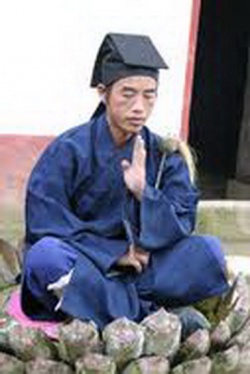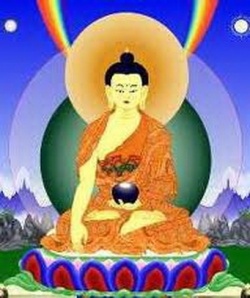Theravada tradition
Although Burma, Thailand, Laos, and Cambodia are each unique states with their own histories, they share important classical traditions. Their writing systems use alphabets derived from the early Indian script known as Brahmi, and their predominant religion has been Theravada Buddhism since the gradual decline of other Indian-derived religions by the thirteenth century. Theravada Buddhism's basic text is called the Tipitaka (Three Baskets), which is composed of discourses ("Sutta"), rules for monastic life ("Vinaya"), and elaborations on the Buddha's teachings ("Abhidhamma"). This canon was carried orally until written down in the Pali language in Ceylon in the first century ad and is considered by its followers to be the most authentic record and teaching of the Buddha. (Theravada means "the way of the elders.")
The Asian Division's collection contains many palm leaf manuscript texts of the Tipitaka and of the extensive commentaries written about it. In 1905, King Chulalongkorn (Rama V), the well-known Thai reformer, presented the Library with the first printed Thai version of the Tipitaka. A Burmese Tipitaka, written in Pali using Burmese script, was presented to the Library in 1949 as part of a large Burmese donation. The Library holds an especially fine collection of Burmese Theravada palm leaf manuscripts in Pali. Theravada Buddhism shaped the early historiography of Burma, Laos, Cambodia, and Thailand. The earlier Thai historical tradition that began well before the fifteenth century is called "tamnan" history and places Thai history in the broader context of the history of Buddhism. Scholars are still debating the value of tamnan writings as historical sources, but a good selection of tamnan texts can be found on microfiche in the Asian Division's holdings. Historical writings in the Chinese style of dynastic histories are a later development in Thailand, dating from the seventeenth century. This chronicle tradition, or "phongsawadan" history, is also represented in the Asian Division's collection in the form of modern microfiche copies of the original documents in Thailand. An important Burmese history, the Hmannan" maha' ya'zawin taw kyi" (The Glass Palace Chronicle), written by a group of scholars appointed by King Bagyidaw in 1829, was part of a 1949 Burmese donation that included a number of other important works of Burmese language and literature.
The Library holds some unique American material that provides a glimpse of nineteenth-century Thailand. The first treaty between the United States and an Asian state was negotiated by Edmund Roberts with the Thai government in 1833. Roberts's journal and personal papers are in the Manuscript Division, as are the papers, dating from 1894 to 1898, of U.S. Minister to Thailand John Barrett. Barrett's large collection of photos of Thailand from the 1890s is held separately in the Prints and Photographs Division. The Library's holdings of the English language newspaper Bangkok Recorder, started by the American Dan Beach ("Mo") Bradley in 1865, are of special interest to historians of nineteenth-century Thailand. The Asian Division holds a small but rare collection of early Southeast Asian works printed by American missionaries in Thailand. The Library also has a major Buddhist periodical, Thammaçhaksu (The Eye of the Law), on film from 1898 onward and in print from 1935 to 1965. European relations with Thailand, of course, predate American contacts, and the Library holds several rare European accounts. Among the earliest is the French diplomat Marquis Alexandré de Chaumont's account of his 1685 mission to Ayutthaya, then the capital of Thailand. Accompanied by a large delegation of Jesuits, Chaumont aimed to convert King Narai to Christianity, a mission doomed to failure. The Rare Book and Special Collections Division has a copy of Chaumont's book, Relation de l'ambassade de Mr le chevalier de Chaumont à la Cour du Roy de Siam, published in Paris in 1686. It also has several editions of Guy Tachard's book, Voyage de Siam, des pères jésuites, envoyés par le roy aux Indes & à la Chine, also first published in 1686. Father Tachard, one of the Jesuits in Chaumont's mission, later returned to continue French intrigues at the court of Ayutthaya.
Thailand has maintained a vibrant classical music tradition, actively supported by the current monarch, King Bhumibol Adulyadej (Rama IX). The Music Division holds a beautiful collection of Thai court musical instruments that were presented to the Library in 1960 by King Bhumibol.

